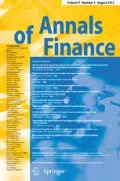Abstract
This paper adapts two recent developments from the bibliometric literature to the problem of assessing the return performance of a financial asset. The result is a quantity-of-quality metric, which is both nonparametric and moment-free. As such, it offers a nonstandard perspective on the informational patterns in asset returns, and accordingly can complement traditional moment-based asset evaluation methods. The proposed approach is simple to apply, and while moment-free, captures intuitively important aspects of asset performance such as location, upside potential, downside risk, and volatility. It can also be expressed as a reward-to-risk ratio, which serves as a counterpart to the Sharpe ratio. Empirical and simulation results suggest that, relative to the Sharpe ratio, the proposed approach prefers assets with moderately higher means and standard deviations, and more favorable skewness.


Similar content being viewed by others
Notes
Dozens of refinements and generalizations of the h-index now exist (e.g., Bornmann et al. 2011), among them the g-index and the e-index (Zhang 2009). Numerous empirical studies of the h-index have also appeared (e.g., Cronin and Meho 2006; Haley 2013), as well as studies regarding its variability across citation databases (Henzinger et al. 2009; Haley 2014b).
This “history” is often truncated to a specific set of recent years; the exact interval varies by application.
The h-index is also commonly computed for individual scholars. In the scholar-level case, the ordered pairs are likewise (article rank, article citation count), but the universe of articles would be those published by a specific scholar across a variety of journals.
In cases where the sample size n is 100–200, the 45-degree line works well. In cases where the sample size is much larger or much smaller, the user might consider rescaling the slope by 100/n. This is a simple generalization that is akin to expressing the rank as percentile rank.
It is, of course, to be expect that the SR will not value skewness as it is only includes mean and standard deviation.
Perturbations of these moments were also explored, which yielded qualitatively similar results.
References
Bawa, V.: Admissible portfolios for all individuals. J Finance 31, 1169–1183 (1976)
Bawa, V.: Safety-first, stochastic dominance, and optimal portfolio choice. J Finance Quant Anal 13, 255–271 (1978)
Bornmann, L., Mutz, R., Hug, S., Daniel, H.-D.: A multilevel meta-analysis of studies reporting correlations between the h-index and 37 different h-index variants. J Informetr 5, 346–359 (2011)
Cronin, B., Meho, L.: Using the h-index to rank influential information scientists. J Am Soc Inf Sci Technol 57, 1275–1278 (2006)
DeMiguel, V., Garlappi, L., Uppal, R.: Optimal versus naive diversification: How inefficient is the 1/N portfolio strategy? Rev Finance Stud 22, 1915–1953 (2009)
Haley, M.: Rank variability of the publish or perish metrics for economics and finance journals. Appl. Econ. Lett. 20, 830–836 (2013)
Haley, M.: Gaussian and logistic adaptations of smoothed safety first. Ann. Finance 10, 333–345 (2014a)
Haley, M.: Ranking top economics and finance journals using Microsoft academic search versus google scholar: How does the new publish or perish option compare? J Am Soc Inf Sci Tecnol 65, 1079–1084 (2014b)
Haley, M.: Shortfall minimization and the naive (1/N) portfolio: an out-of-sample comparison. Appl. Econ. Lett. 23, 926–929 (2016)
Haley, M.: K-fold cross validation performance comparisons of six naive portfolio selection rules: How naive can you be and still have successful out-of-sample portfolio performance? Ann. Finance 13, 341–353 (2017)
Haley, M., Whiteman, C.: Generalized safety first and a new twist on portfolio performance. Econom Rev 27, 457–483 (2008)
Haley, M., McGee, M.: KLICing there and back again: portfolio selection using the empirical likelihood divergence and the Hellinger distance. J. Empir. Finance 18, 341–352 (2011)
Haley, M., McGee, M., Walker, T.: Disparity, shortfall, and twice-endogenous hara utility. Econom Rev 32, 524–541 (2012)
Haley, M., Paarsch, H., Whiteman, C.: Smoothed safety first and the holding of assets. Quant Finance 13, 167–176 (2013)
Hanoch, G., Levy, H.: The efficiency analysis of choices involving risk. Rev. Econ. Stud. 36, 335–346 (1969)
Henzinger, M., Suñol, J., Weber, I.: The stability of the h-index. Scientometrics 84, 465–479 (2009)
Hirsch, J.: An index to quantify an individual’s scientific research output. Proc. Natl. Acad. Sci. U.S.A. 102, 16569–16572 (2005)
Kumar, M.: Evaluating scientists: citations, impact factor, h-index, online page hits and what else? IETE Tech Rev 26, 165–168 (2009)
Markowitz, H.: Portfolio selection. J Finance 7, 77–91 (1952)
Roy, A.: Safety first and the holding of assets. Econometrica 20, 431–449 (1952)
Sharpe, W.: The sharpe ratio. J Portf Manag 21, 49–58 (1994)
Sortino, F., Price, L.: Performance measurement in a downside risk framework. J Invest 3, 59–65 (1994)
Stutzer, M.: A portfolio performance index. Finance Anal J 56, 52–61 (2000)
Stutzer, M.: Portfolio choice with endogenous utility: a large deviations approach. J Econom 116, 365–386 (2003)
Zhang, C.: The e-index, complementing the h-index for excess citations. PLoS ONE 4, e5429 (2009)
Author information
Authors and Affiliations
Corresponding author
Rights and permissions
About this article
Cite this article
Haley, M.R. A nonparametric quantity-of-quality approach to assessing financial asset return performance. Ann Finance 14, 343–351 (2018). https://doi.org/10.1007/s10436-018-0319-2
Received:
Accepted:
Published:
Issue Date:
DOI: https://doi.org/10.1007/s10436-018-0319-2




